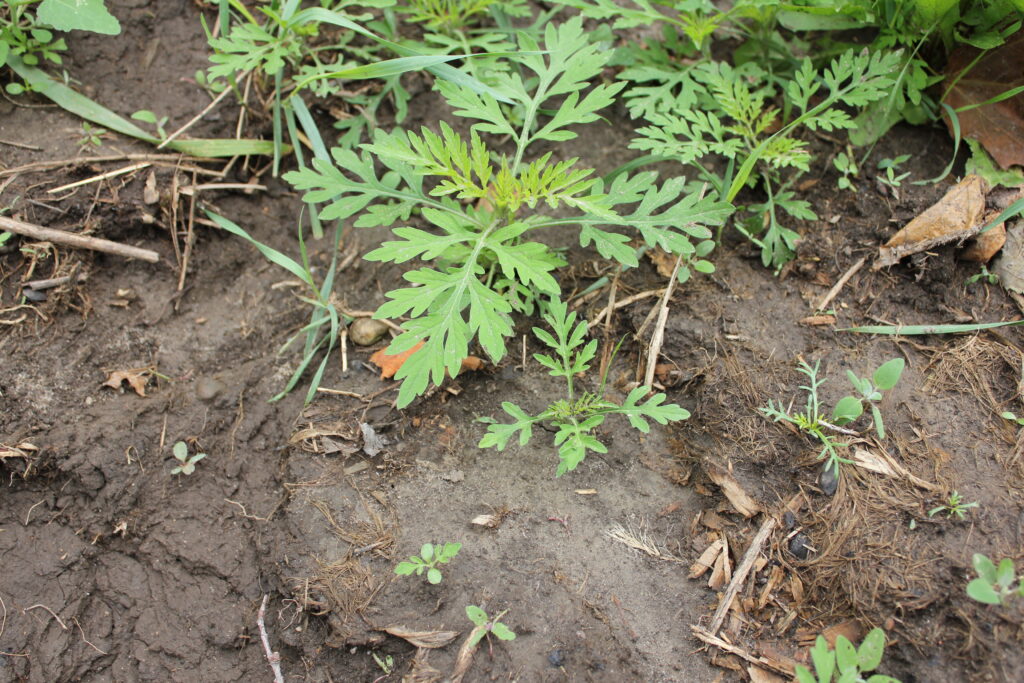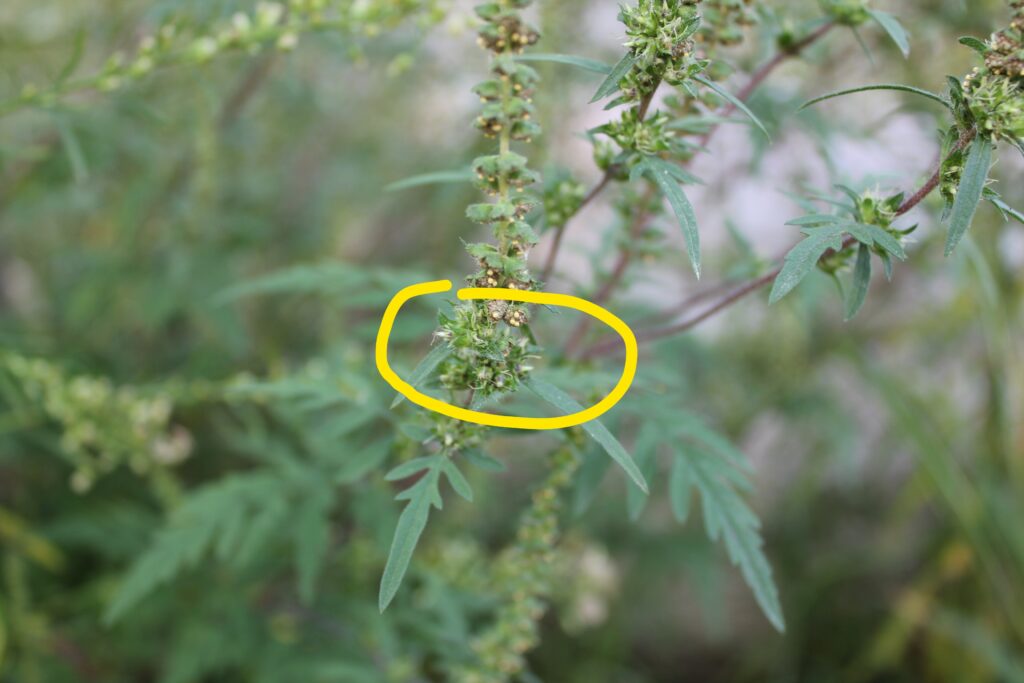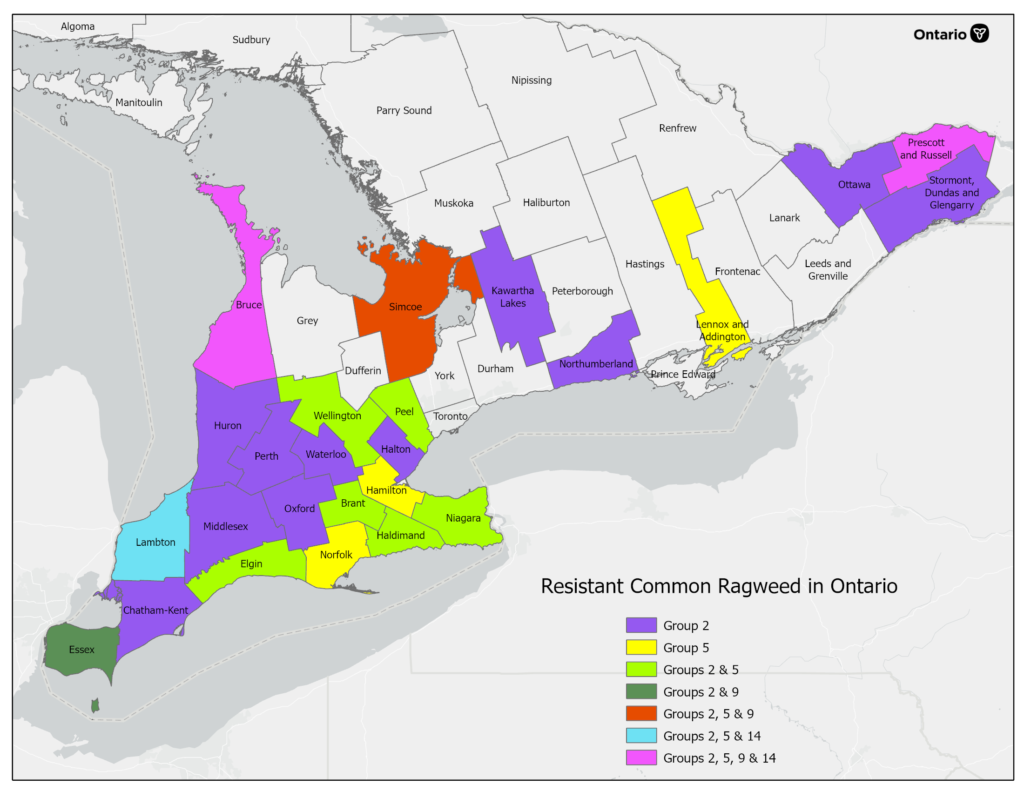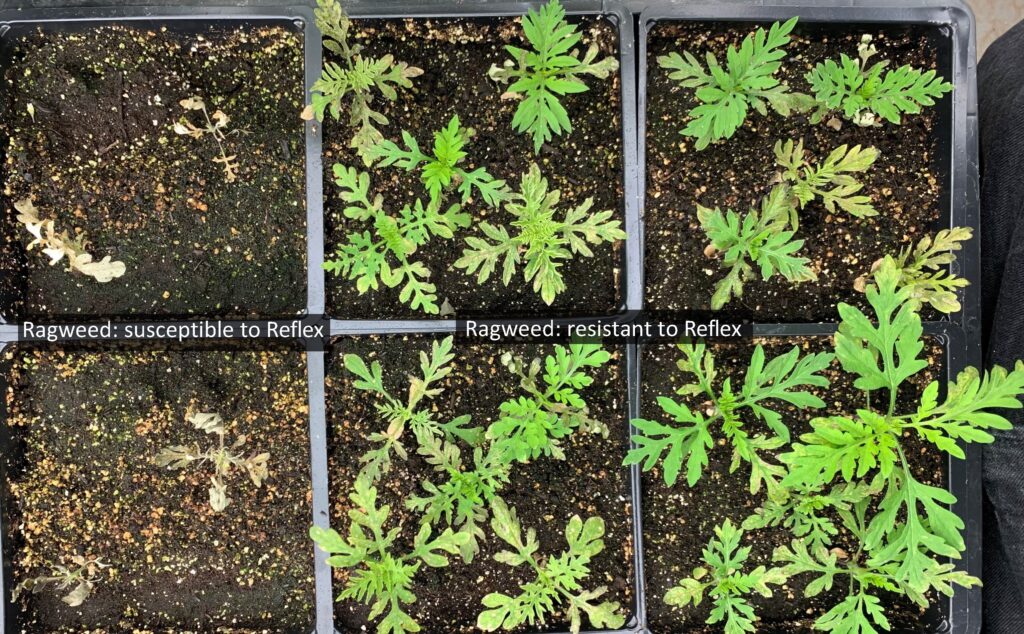INTRODUCTION:
This post will serve as a repository for the latest in the integrated management of common ragweed in field crops.
IDENTIFICATION:
SPECIES INFORMATION
Lifecycle: Annual
Propagation: Reproduces by seed, unisexual.
Emergence: Most seedlings emerge during a short window in early spring, typically May, and end by the beginning of June.
Range and habitat: Most common in southern and central regions of Eastern Canada, establishes in all soil types.
Competitiveness: Extremely competitive at high densities. In field crops yield losses can approach 90 percent.
IDENTIFICATION CLUES
Leaves
Cotyledons: round or orbicular with short petiole and fleshy appearance.
Young leaves: first two leaves are divided into 3 lobes.
Mature leaves: Opposite leaf orientation, except towards the end of branches where they may be alternate; deeply divided, densely hairy but short hairs.
Mature Plant
Stem: Erect, hairy and branched; up to 1.5 m in height.
Flowers: Male and female flowers exist on separate flower heads (monoecious). The pollen producing male flowers are most visible and resemble upside down bowls. The seed producing female flowers are below the male flowers and located in the leaf axils. Flowers from August to October.
OFTEN MISTAKEN FOR
I know it’s NOT … because…
Wild carrot … Common ragweed has round cotyledons compared with the extremely narrow cotyledons of wild carrot. The leaves of wild carrot are more finely divided than common ragweed and have a distinctive smell when the plant tissue is crushed.
Biennial wormwood … Comparing the leaves of each plant will make their differences obvious. The leaves of common ragweed are hairy and have rounded edges whereas biennial wormwood leaves lack hair and have sharp edges.





HERBICIDE RESISTANT POPULATIONS
The following table and map summarizes the occurrence of herbicide resistant common ragweed in Ontario.
| WSSA Group | Counties with confirmed populations (April – 2023) |
| 2 (e.g. FirstRate) | Bruce; Chatham-Kent; Elgin; Essex; Haldimand; Halton; Huron; Kawartha Lakes; Lambton; Middlesex; Niagara; Northumberland; Ottawa; Oxford; Perth; Prescott-Russell; Simcoe; Stormont, Dundas, and Glengarry; Wellington |
| 5 (e.g. Aatrex, Sencor) | Brant; Bruce; Elgin; Haldimand; Hamilton; Lambton; Lennox and Addington; Niagara; Norfolk; Wellington |
| 9 (e.g. glyphosate) | Essex, Simcoe |
| 14 (e.g. Reflex, Blazer) | Bruce, Lambton, Prescott-Russell |
| Multiple Resistant 2 & 5 | Peel; Simcoe |
| Multiple Resistant 2&9 | Essex |
| Multiple Resistant 2,5 & 14 | Bruce, Lambton, Prescott-Russell |

SYMPTOMS: GROUP 14 RESISTANT RAGWEED
When sprayed under growth room conditions, resistant common ragweed plants have displayed mild to moderate levels of bronzing (necrosis) to leaves that were present at the time of application. The injury is similar to what one might experience with Reflex or Blazer applied to emerged soybeans.

SOYBEANS: PREEMERGENCE HERBICIDES
The table below is a summary of all publicly funded research on common ragweed control with preemergence herbicides conducted in Ontario since 2010. In general, it is difficult to get consistent good control of common ragweed. Herbicides that contain a high rate of metribuzin have generally provided the best level of control.
| Herbicide Name(s) | Group | Average Control (%) | Comments |
| Canopy Pro + Boundary* | 2,5,15 | 92 | Control ranged from 69-1001 |
| Triactor EZ | 2,5,14 | 88 | Control ranged from 61-1001 |
| Sencor 75DF | 5 | 83 | Control ranged from 78-952 |
| Bifecta EZ | 5,14 | 77 | Control ranged from 59-981 |
| Authority + Boundary Liquid | 14,5,15 | 75 | Control ranged from 54-981 |
| Fierce EZ | 14,15 | 70 | Control ranged from 43-891 |
| Classic + Valtera + Prowl H2O | 2,14,3 | 70 | Control ranged from 0-1001 |
| Commenza | 2,5,15 | 67 | Control ranged from 0-941 |
| Authority Supreme | 14,15 | 47 | Control ranged from 0-941 |
| Zidua SC | 15 | 30 | Source: Soltani et al., 2019 |
| Frontier Max | 15 | 13 | Source: Soltani et al., 2019 |
| Dual II Magnum | 15 | 12 | Source: Soltani et al., 2019 |
2From VanWely et al., 2014 and Byker et al., 2018.
* The rate of metribuzin in the Canopy Pro + Boundary tank-mix is equivalent to applying a 1050 g/ha (420 g/acre) rate of Sencor 75DF. As such, there are soil type restriction specified on the label which would exclude this tank-mix from being used (see image below).

RAINFALL NEEDED TO ACTIVATE PRE HERBICIDES.
An Ontario study evaluated the influence of precipitation on common ragweed efficacy. When there was less than 20 mm of rainfall within 7 days of application, ragweed control was not acceptable with soil applied herbicides. Conversely, heavy rainfall (~70 mm) also reduced weed control but was not as detrimental as too little rainfall.
| Herbicide | Rate/acre | Rainfall (within 7 days of application) | Common ragweed control (4 weeks after application) |
| Dual II Magnum + Sencor 75DF | 0.7 L + 350 g | 21 mm | 100 |
| Dual II Magnum + Sencor 75DF | 0.7 L + 350 g | 70 mm | 88 |
| Dual II Magnum + Sencor 75DF | 0.7 L + 350 g | 13 mm | 41 |
OTHER PRE HERBICIDES?
The active ingredient “clomazone” (e.g. COMMAND 360), a group 13 herbicide, is rarely used for weed control in soybeans primarily because the label does not allow winter wheat to be planted until 16 months after its application. Clomazone can cause unacceptable levels of crop injury to winter wheat that is planted in the fall following its application.
Of the published research, clomazone has demonstrated good control of common ragweed.
| Clomazone rate (360 g/L concentration) | Average Control | Comments |
| 800 g a.i./ha (0.89 L/acre of product) | 91 | Source: Jordan et al., 1994 |
| 840 g a.i./ha (0.93 L/acre of product) | 93 | Control ranged from 93-98 (Troxler et al., 2002) |
| 600 g a.i./ha (0.67 L/acre of product) | 90 | Control ranged from 88-93 (Scott et al., 2002) |
SOYBEANS: POSTEMERGENCE HERBICIDES
| Herbicide | Group | Labelled Stage | Average | Minimum | Maximum |
| FirstRate + Agral 90 | 2 | <8 leaf | 99 | 99 (4 leaf) | 99 (8 leaf) |
| Classic + Agral 90 | 2 | <6 leaf | 86 | 86 (2-4 leaf) | 86 (2-4 leaf) |
| Cleansweep | 2,6 | < 6 leaf | 81 | 35 (8 leaf) | 100 (2 leaf) |
| Reflex + Turbocharge | 14 | <4 leaf | 74 | 43 (20 leaf) | 92 (2-4 leaf) |
| Ultra Blazer | 14 | <8 leaf | 61 | 35 (16 leaf) | 83 (4 leaf) |
| Pursuit + Agral 90 + 28% UAN | 57 | < 2leaf | 57 | 22 (16 leaf) | 79 (2-4 leaf) |
| Basagran Forte | 6 | < 6 leaf | 50 | 13 (14 leaf) | 89 (2-4 leaf) |
Reflex or Blazer have been the most commonly used herbicides to control emerged common ragweed in soybeans. The following best practices will help optimize control of common ragweed that is not group 14 resistant.
- A soil applied herbicide that is effective on common ragweed should be applied first. A percentage of the ragweed population will typically “escape” this application. Target the post-emergent application of Reflex or Blazer to ragweed escapes when at the 2-4 leaf stage of growth. This typically occurs at 14-28 days after planting.
- Reflex should be applied during the day. Optimum control is generally achieved between 4 and 9 pm.
- Coverage is key to getting good control. A minimum of 20 U.S. gallons/acre (200 L/ha; 80 L/acre) should be used. Flat fan type tips are highly recommended. Air induction or spray quality larger than coarse droplet tips are NOT recommended. Higher water volumes are desirable with dense canopy and thick stands. Hot humid conditions will increase the level of bronzing/burning on the soybean leaves.
- Always use an adjuvant with Reflex.
MAXIMIZING CONTROL OF BENTAZON
Bentazon (group 6 – Basagran Forte) is the only option for control of emerged group 2 and group 14 resistant common ragweed. Historically this product has not been overly effective, primarily because it needs to be applied to very small common ragweed and it provides no residual control to prevent the emergence of common ragweed after application. Here is a review of what published research has revealed about maximizing control of bentazon.
Tip # 1: Apply at the highest labelled rate of 0.9 L/acre (1080 gai/ha) and when common ragweed is less than the 6 leaf stage (4 cm tall).
| Basagran Forte rate/acre | Common ragweed stage | Control (%) |
| 0.9 L | 2 leaf | 99 |
| 0.9 L | 4 leaf | 89 |
| 0.9 L | 6 leaf | 92 |
Tip # 2: Tank-mixing with Pinnacle or Pursuit enhanced control of common ragweed. The addition of 28% UAN did not.
| Herbicide | Common ragweed stage | Control (%) |
| Basagran Forte | 4-6 leaf | 49 |
| Basagran Forte + 28% UAN | 4-6 leaf | 50 |
| Basagran Forte + Pinnacle + NIS + 28% UAN | 4-6 leaf | 69 |
| Basagran Forte + Pursuit (Cleansweep) + NIS + 28% UAN | 4-6 leaf | 88 |
Tank-mixing with Reflex has historically improved common ragweed control. It is unknown whether it still adds value for the control of group 14 resistant common ragweed but it does improve control of other weeds like redroot pigweed.
| Herbicide | Control (%) | Range in Control (%) |
| Basagran Forte | 46 | 0-70 |
| Basagran Forte + Reflex | 83 | 53-99 |
| Reflex + Agral 90 | 92 | 86-99 |
Tip # 3: Use a minimum water volume of 20 gal/acre (200 L/ha; 80 L/acre)
INFLUENCE OF COVER CROPS AND OTHER CULTURAL METHODS OF CONTROL
Common ragweed seed has been reported to germinate at higher percentages when exposed to light and greater fluctuations in soil temperature (Pickett and Baskin, 1973). Such conditions are most likely to occur at the soil surface. One could assume that fall seeded cover crops that are roller crimped to act as mulch for spring planted crops would reduce germination of common ragweed seed because they presumably provide an environment with less light exposure and more stability in the range of soil temperatures. A Maryland study in organic cropping systems observed lower common ragweed emergence in corn plots where a fall seeded hairy vetch cover crop was terminated with a roller crimper compared to disking (Teasdale and Mirsky, 2015). However, a North Carolina study found no difference in common ragweed populations in plots consisting of cover crops compared to plots where no cover crops were included (Lassister et al., 2011).
More recently, a 2021 study conducted in Virginia by Beams and colleagues evaluated the influence of planting date, harvest weed seed control (e.g. Harrington Seed Destructor, Seed Terminator) and winter covers (e.g. winter wheat, cereal rye) on common ragweed populations in soybean. They observed the following:
- Late planting (July vs. May) was the most influential means of reducing ragweed populations. This would only be of practical application in areas where double cropped soybeans are possible, since the yield penalty from planting that late would be prohibitive.
- Planting a winter cover significantly reduced ragweed densities at 2 of the 3 trial locations and by as much as 49%.
- Harvest weed seed control significantly ragweed density at 1 of the 3 locations by 43%.
INFLUENCE OF TILLAGE
A study conducted in Pennsylvania, Delaware and New Jersey found that spring tillage, performed at a depth of 10 cm (4″) delayed common ragweed emergence by two weeks, but reduced density by ~28% (Myers et al., 2005). Conversely, a Nebraska study found that spring tillage did not influence ragweed emergence and density. A French study demonstrated that seed germination was greatest when left on the soil surface and decreased at greater burial depths with no germination occurring when seed was buried 10-12 cm deep (Guillemin and Chauvel, 2011). A 5 year study conducted by Vencill and Banks in 1994, observed higher common ragweed seed in the soil of a no-till cropping systems when compared to conventional cropping systems. Presumably, this was because tillage reduced the abundance of common ragweed, and therefore seed production.
INTREGATED MANAGEMENT SUMMARY
- Plant an over-wintering crop (e.g. winter wheat, triticale, cereal rye) – could reduce ragweed density by ~50%
- Spring tillage, such as a high speed disk, may reduce ragweed density by as much as ~28%
- Common ragweed has a relatively small germination window. Delayed planting, may allow for more ragweed seedlings to be killed by tillage or effective pre-plant burndown herbicides.
- Planned, two-pass herbicide programs will increase overall weed control and reduce common ragweed seed being dispersed onto the soil.
